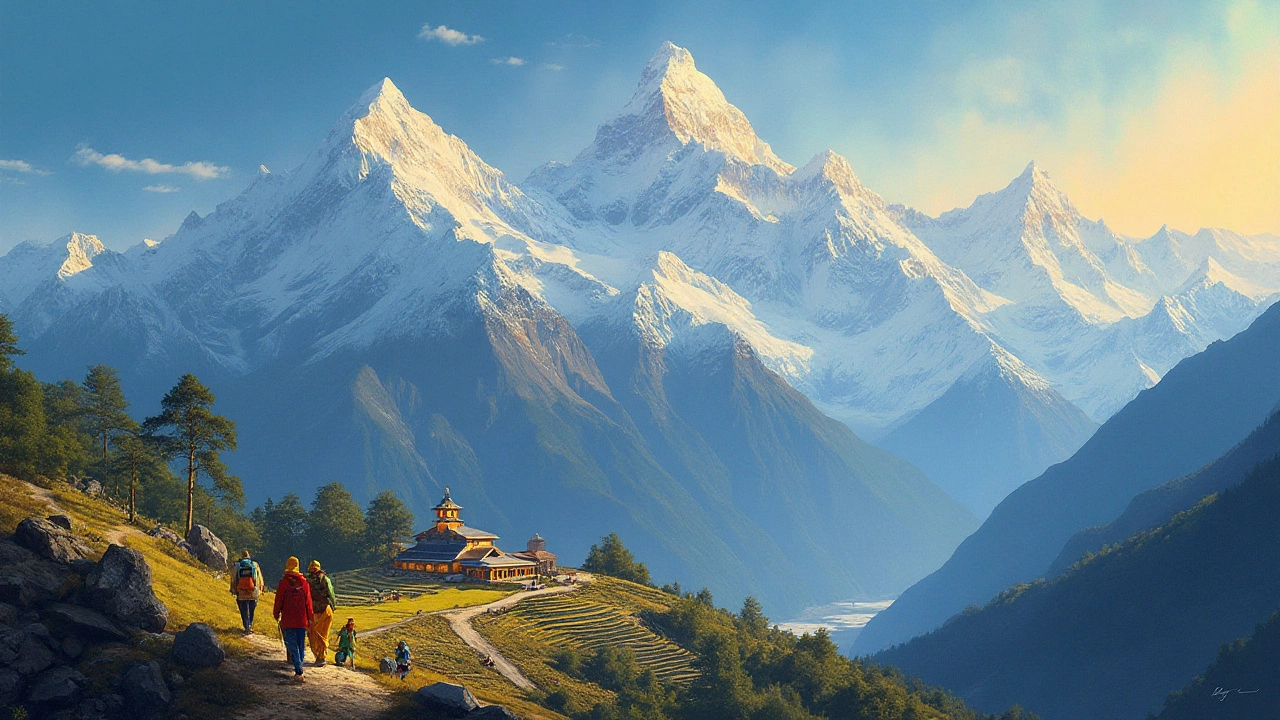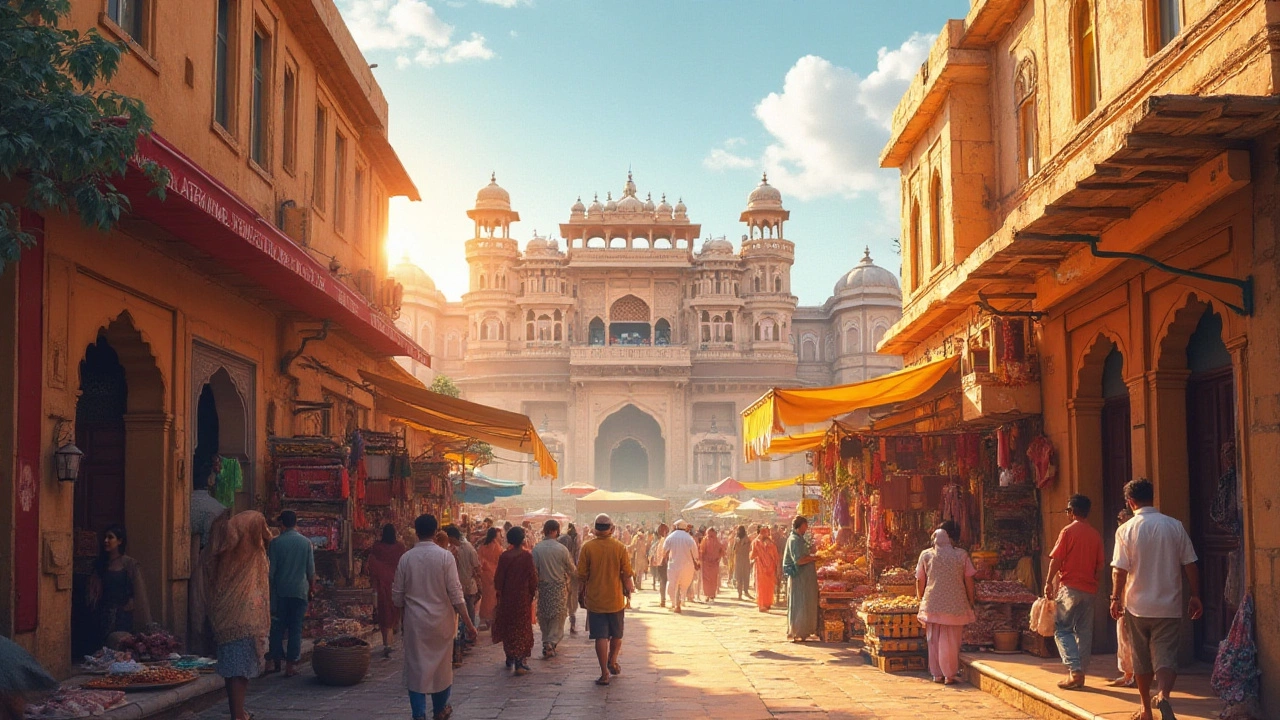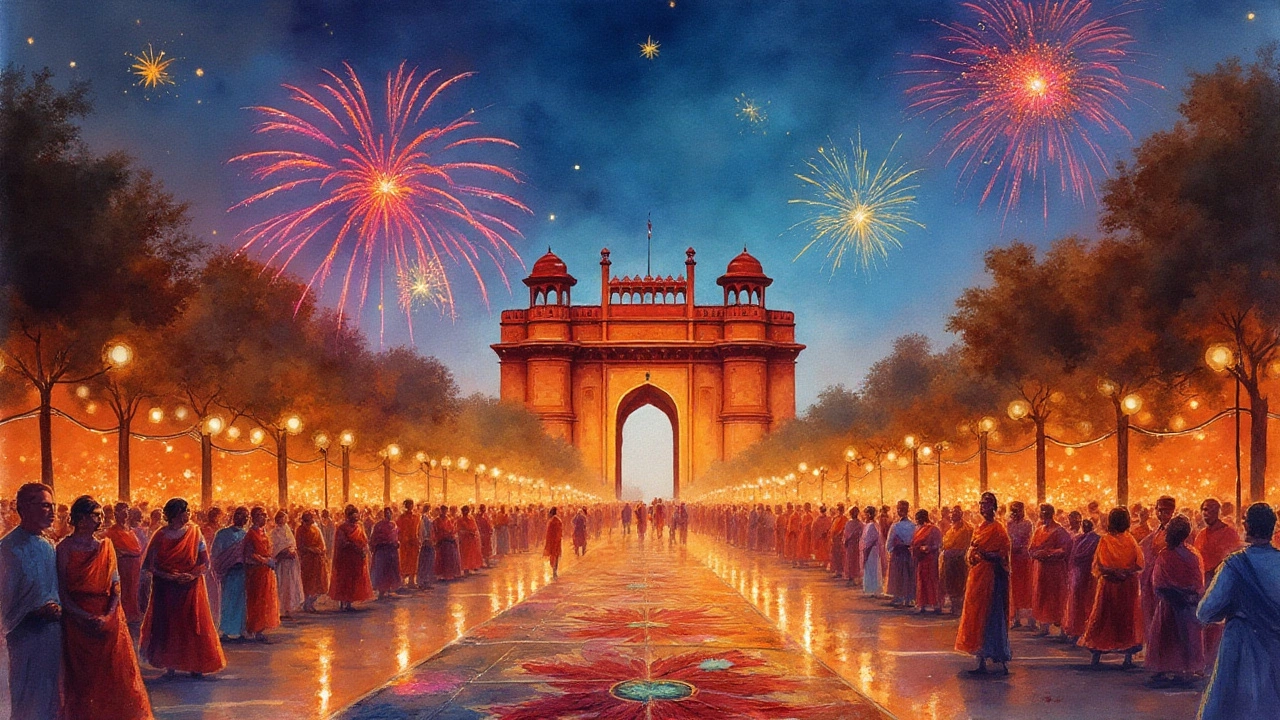Northern India is one of those magical regions that effortlessly enchants visitors with its mesmerizing landscapes and rich tapestry of culture. Picture this: lofty Himalayan ranges, bustling bazaars, historic palaces, and the echoes of prayers from ancient temples. A trip to northern India is a journey into a land where the past and present walk hand in hand.
While northern India is a year-round destination, every season paints this vibrant region differently, bringing about its own unique set of experiences. It’s the cooler months from October to March that truly offer the stage for the region to shine at its best. During these months, the weather is just perfect for exploration, making it ideal for those eager to unravel the mysteries from Delhi's famed streets to the surreal beauty of Rajasthan's palaces.
So pack your bags and ready yourself for a whirlwind of colors, tastes, and experiences in northern India. And remember, the journey is just as important as the destination. Each moment spent amidst the dynamic heart of India is a tale waiting to be told.
- Climate and Weather Conditions
- Festivals and Events
- Destinations to Visit
- Travel Tips and Preparations
- Cultural Heritage and Attractions
Climate and Weather Conditions
When planning a trip to Northern India, it's crucial to understand the climate and weather patterns that define this diverse region. The climatic conditions across northern India vary significantly due to its vast expanse, ranging from the lush valleys at the base of the mighty Himalayas to the scorching deserts of Rajasthan. The region experiences three main seasons: summer, monsoon, and winter, each painting a different yet mesmerizing picture of the landscape.
During the summer months from April to June, temperatures can soar dramatically, especially in the plains where it often exceeds 40°C. Cities like Delhi, Agra, and Jaipur can become overwhelmingly hot, with the sun blazing fiercely overhead. However, this is the best time to explore higher altitude regions such as Himachal Pradesh and Uttarakhand, where the climate remains pleasantly cool, offering a respite from the heat of the plains.
The monsoon months of July to September bring much-needed relief with rains sweeping across the region. While the showers rejuvenate the earth, turning it into a lush green landscape, they also bring challenges like humidity and potential travel disruptions due to waterlogged roads and landslides in hilly areas. Despite these challenges, the scenic beauty during this time is unparalleled, as nature comes alive in all its glory.
It is the winter season from October to March that attracts the most travelers to Northern India. The weather during these months is crisp and cool, making it a perfect time for exploration. This is when you can wander through the historical lanes of Rajasthan, visiting its majestic forts and palaces, or gaze in awe at the architectural beauty of the Taj Mahal without breaking a sweat. The northern states host numerous festivals during this time, adding a vibrant hue to the cultural tapestry of the region.
"The Himalayas in winter are simply spellbinding," shares travel enthusiast Rajiv Malhotra. "There's a serenity and majesty to these mountains wrapped in snow that you can't find anywhere else."
Yet, travelers should note that northern India can get quite cold in the height of winter, particularly in the higher altitudes. Areas like Kashmir often see heavy snowfall, turning them into picturesque winter wonderlands. Therefore, carrying appropriate winter gear is advisable, especially if your journey takes you into the mountainous regions.
For those with an adventurous spirit, winter might also mean opportunities for skiing and snowboarding in places like Gulmarg, and experiencing the enthralling chill of a traditional Kashmiri winter. Whether you're basking in the desert sunshine or standing amidst the foggy chill of Himalayan vistas, each season offers its own unique stories, making northern India a year-round delight for travelers.
Festivals and Events
The fabric of northern India is woven with a kaleidoscope of festivals and events that brilliantly highlight the region’s cultural diversity and centuries of traditions. From the exhilarating celebrations of Diwali, known as the festival of lights, to Holi, where the air itself becomes a canvas of vibrant colors, every festival offers a unique glimpse into the soul of Northern India. During these festivals, streets come alive with joy, music, and dance, providing travelers with immersive experiences that words can hardly capture.
One of the unmissable events is the Durga Puja in Delhi, where temporary shrines are erected, and intricate sculptures of Goddess Durga are worshipped. This event pulls crowds from all corners, creating a lively atmosphere filled with rhythmic beats of the 'Dhak' drums. Then there's the mesmerizing Pushkar Camel Fair in Rajasthan, a colorful spectacle that combines agrarian markets with festive allure, which offers visitors a chance to witness traditional dances, contests, and live folk music performances.
For those seeking spiritual depth, a visit during the Kumbh Mela in Haridwar, one of the largest religious gatherings on earth, reveals a profound side of Indian culture. Here, millions of devotees take part in holy dips along the sacred Ganges, marking a spiritually uplifting experience. A traveler once remarked, "Witnessing the Kumbh, you stand on ground that seems to pulse with the rhythms of ages past."
Think of the International Yoga Festival held in Rishikesh every March, drawing wellness enthusiasts worldwide to explore the roots of this ancient practice at ashrams dotting the banks of the Ganges. Another noteworthy event is the Hemis Festival in Ladakh, an extravaganza showcasing masked dances and cultural performances in the remote yet breathtaking locales of the Himalayas. These diverse festivals are not just events but gateways into understanding and participating in the vibrant threads that make up northern India’s identity.
For a truly enriching travel experience, planning your visit around these festivals is a must. Not only do these events provide a rich cultural backdrop to your journey, but they also invite you to be part of India’s living history. Whether it’s the electric vibe of a city street during Diwali or the serene chants in a remote monastery, the festivals of northern India add layers of depth and warmth to your travels, ensuring stories that stay with you long after you leave.

Destinations to Visit
The treasures of Northern India are as vast as they are diverse, making it a perfect playground for travelers seeking wonder and adventure. One of the crown jewels of this region is undoubtedly the city of Delhi, an eclectic blend of ancient charm and contemporary vibrancy. With its crowded streets whispering secrets of bygone eras, the capital is home to remarkable landmarks such as the Red Fort, Humayun's Tomb, and the towering Qutub Minar. Each monument here tells a story intricately interwoven with India's history. As you stroll through its lanes where history meets modernity, don’t forget to experience the sensory explosion that is Chandni Chowk, a bustling market teeming with flavors and colors unique to this part of the world.
Further down south, you'll find the awe-inspiring city of Agra, an inevitable stop for those traversing northern routes. Of course, the Taj Mahal, often hailed as a 'teardrop on the cheek of time,' is the masterpiece that draws millions. It's this iconic structure – a symbol of love and passion – where the soul of India can truly be felt. Agra isn't just about the Taj though; the Agra Fort and the 'Baby Taj' or Itimad-ud-Daulah's tomb also beckon with tales from the Mughal era.
Embrace the allure of Rajasthan where cities like Jaipur, known as the Pink City, offer lessons in opulence and grandeur. Its majestic palaces, such as the Hawa Mahal and the Amer Fort, teem with royal history. The stories enshrined within the city walls are enough to satiate any history buff's hunger for knowledge.
"India is, the world's largest open-air museum." — Rolf Potts, renowned travel writer
Up in the north, serenity takes command in the hilly terrains of Himachal Pradesh and Uttarakhand. Places like Shimla, Manali, and Mussoorie are renowned for their scenic beauty and the peace they offer those escaping urban chaos. Amid these towering mountains and lush valleys resides a softer side of northern India, one that whispers tranquility.
For devotees and seekers of spiritual solace, Varanasi, the eternal city on the banks of the holy Ganges, offers a glimpse into the soul of spiritual India. Watching the Ganga Aarti, a grand ritual conducted at the ghats, promises an experience that touches the heart and soul, connecting you to the timeless spirit of India. Here, life and death coalesce in bizarre harmony, offering visitors a chance to reflect on the profound mysteries of existence.
The landscape of Northern India is as varied as the experiences it offers. It challenges you, opens your mind, and fills your senses with a kaleidoscope of experiences that stay with you long after the journey ends.
| Destination | Best Time to Visit | Main Attractions |
|---|---|---|
| Delhi | October to March | Red Fort, Qutub Minar, India Gate |
| Agra | November to March | Taj Mahal, Agra Fort |
| Jaipur | October to March | Amber Fort, Hawa Mahal |
| Varanasi | November to February | Ganges Ghats, Ganga Aarti |
Travel Tips and Preparations
Embarking on a journey to the enchanting northern India, especially during the cool and inviting months from October to March, requires a bit of planning to ensure a smooth and enjoyable experience. Given the region's diverse geographical and cultural landscape, it's essential to prepare for varied terrains and temperatures. Remember, northern India is not just a visual feast but also an adventure for the senses. From savouring spicy street food in the bustling markets of Delhi to the crisp mountain air in Himachal Pradesh, each stop offers a multitude of sensory delights.
Speaking of sensory experiences, one thing you'll want to prepare for is the region's vibrant culinary scene. While the food is delicious, it can be quite different from what many international travelers are accustomed to. Consider starting with milder dishes and gradually exploring spicier options to ease your palate into the rich flavors of the North. Remember to stay hydrated – bottled water is your best friend. Packing a reliable water bottle with a built-in filter can also prove invaluable during longer trips to remote areas.
Navigating northern India requires some strategic packing, given the variance in climates due to its geographical diversity. Light, breathable clothing is recommended for day-time excursions, while evenings might require warmer attire, particularly in higher altitudes. Adventurous treks across the Himalayas or serene visits to the Taj Mahal at sunrise call for comfortable yet respectful attire, as certain sites may have dress codes. A compact umbrella or raincoat can also be handy when sudden showers make an appearance.
Understanding the cultural nuances is another facet of making your Indian journey seamless. While English is widely spoken in major tourist areas, learning a few basic phrases in Hindi can enhance interactions and evoke a connection with locals. Remember to respect local customs and traditions, as these form the heart of Indian ethos. When visiting religious sites, for instance, modesty in dress is appreciated, and it’s customary to remove shoes as a sign of respect. A lightweight scarf or shawl can be a versatile addition, doubling as a cover-up when needed.
Regarding connectivity and navigation, obtaining a local SIM card is a practical option, as it provides easy access to maps, travel apps, and instant communication. Several service providers offer affordable tourist packages catering to short and extended stays. For those venturing to more remote areas where connectivity might waver, it’s worth keeping physical maps or downloading offline maps in advance. Reliable navigation ensures you don’t miss out on hidden gems and avoid getting lost in bustling regions.
For those who love planning and detailed schedules, creating an itinerary that balances prominent landmarks and off-the-beaten-path excursions is key. While places like Jaipur's Amber Fort and Agra's Taj Mahal are must-visits, carving out time for local festivals or wildlife safaris adds depth to your travel narrative. Flexibility remains crucial, as the charm of northern India can often lead to unforeseen detours and spontaneous adventures. As Nobel laureate Rabindranath Tagore wisely remarked,
'The journey is long and I must travel far, but my heart will rest at every milestone.'Embrace the unexpected, for these moments often define the most treasured memories.

Cultural Heritage and Attractions
The heart of Northern India beats strong with a rich cultural heritage that is as diverse as it is captivating. Stretching from the snow-capped Himalayas to the fertile plains of the Ganges, this region is a melting pot of history, culture, and spirituality. The cultural heritage of Northern India is most visible in its iconic monuments, vibrant festivals, and the timeless traditions that continue to be cherished by its people. A journey through this region unfolds like a colorful tapestry, embroidered with tales of ancient kingdoms, spiritual enlightenment, and the pursuit of artistic excellence.
The northern parts of India boast many UNESCO World Heritage Sites that whisper stories from the past. The city of Agra, home to the legendary Taj Mahal, is a testament to the architectural prowess of the Mughal era. This marble masterpiece, often described as a 'teardrop on the cheek of time', attracts millions of visitors every year, each drawn to its ethereal beauty and the romantic tale behind its creation. But Agra is not just about the Taj. The impressive Agra Fort, a red sandstone monument, offers a glimpse into the opulent lifestyle of the Mughal emperors and provides spectacular views of the Yamuna River.
Delhi, the sprawling capital city, is a microcosm of Northern India's rich cultural past and dynamic present. From the towering Qutub Minar, one of the world's tallest minarets, to the majestic Red Fort, these structures echo the imperial ambitions of Delhi's many rulers. Walking through Old Delhi, with its serpentine lanes and sensory overload, takes one back in time. Here, the scent of spices mingles with chatter from bustling markets, while rickshaws weave through streets lined with historical gems like the Jama Masjid and Chandni Chowk. A mere stone's throw away lies New Delhi with its grand colonial architecture and impressive landmarks like India Gate and Rashtrapati Bhavan.
Rajasthan is often termed as the 'Land of Kings', and rightly so. This desert state is dotted with grand forts and lavish palaces that tell tales of valor and romance. The pink city of Jaipur is a starting point, where the Hawa Mahal and the Amber Fort are quintessential stops for any traveler. Venturing further, the city of Jodhpur, with its blue-hued buildings, nestles the formidable Mehrangarh Fort. It's worth climbing to the top for breathtaking views. Elsewhere in Rajasthan, you’ll find the serene beauty of Udaipur’s Lake Palace, seemingly floating on the waters of Lake Pichola.
Step into the ethereal landscapes of Varanasi, one of the world's oldest living cities. Here, the coexistence of life and death manifests along the ghats of the Ganges, where pilgrims perform rituals that have remained unchanged for centuries. The flickering diyas during the Ganga Aarti, a nightly ritual, cast a warm glow that adds to the city’s mystical aura. Varanasi is also a cradle of Indian handicrafts, with its luxurious silk fabrics and intricate wooden toys highlighting the craftsmanship that has been passed down through countless generations.
"Traveling alone can be a very inspiring experience as well. It's a beautiful way to find out about yourself." – Diane von Furstenberg
To fully appreciate Northern India's cultural tapestry, one must not overlook its spirited festivals that explode in a riot of colors, sounds, and aromas. The fervor of Diwali, the festival of lights, illuminates cities, towns, and villages alike, transforming them into twinkling wonderlands. Holi, the festival of colors, is yet another unmissable celebration, where people across the region come together to douse each other in vibrant powders, symbolizing the victory of good over evil. Participating in these festivals provides an authentic glimpse into the collective exuberance and traditions that characterize northern India.
